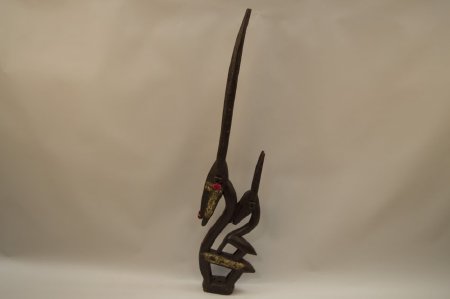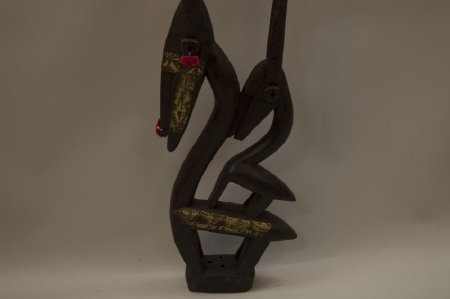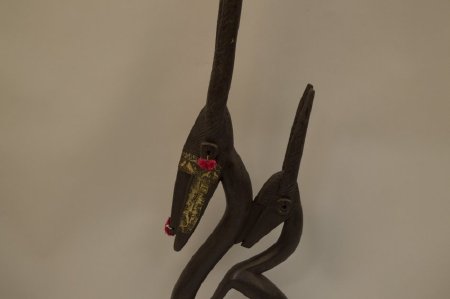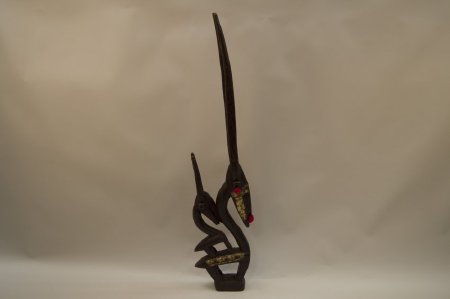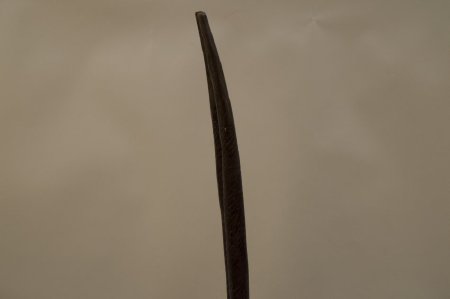Title:
Tji Wara Society, Female Antelope Headdress
Object Name:
Headdress, Tji Wara, Bamana, Female
Other Name:
Ritual, Antelope, Bambara
Place of Origin:
Bamana (Bambara), Mali, Africa
Provenance:
Aboriginal Indigenous Art.
The Tji Wara Society members use a headdress representing, in the form of an antelope, the mythical being who taught men how to farm. The word tji means “work” and wara means “animal,” thus “working animal.” There are antelopes with vertical or horizontal direction of the horns. In the past the purpose of the tji wara association was to encourage cooperation among all members of the community to ensure a successful crop. In recent time, however, the Bambara concept of tji wara has become associated with the notion of good farmer, and the tji wara masqueraders are regarded as a farming beast. The Bambara sponsor farming contests where the tji wara masqueraders perform. Always performing together in a male and female pair, the coupling of the antelope masqueraders speaks of fertility and agricultural abundance. According to one interpretation, the male antelope represents the sun and the female the earth. The antelope imagery of the carved headdress was inspired by a Bambara myth that recounts the story of a mythical beast (half antelope and half human) who introduced agriculture to the Bambara people. The dance performed by the masqueraders mimes the movements of the antelope. Antelope headdress in the vertical style, found in eastern Bambara territory, have a pair of upright horns. The male antelopes are decorated with a mane consisting of rows of openwork zigzag patterns and gracefully curved horns, while the female antelope supports baby antelopes on their back and have straight horns. The dancers appeared holding two sticks in their hands, their leaps imitating the jumps of the antelopes. From the artistic point of view the tji wara are probably the finest examples of stylized African art, for with a delicate play of line the sensitive carvings display the natural beauty of the living antelope.
The Tji Wara Society members use a headdress representing, in the form of an antelope, the mythical being who taught men how to farm. The word tji means “work” and wara means “animal,” thus “working animal.” There are antelopes with vertical or horizontal direction of the horns. In the past the purpose of the tji wara association was to encourage cooperation among all members of the community to ensure a successful crop. In recent time, however, the Bambara concept of tji wara has become associated with the notion of good farmer, and the tji wara masqueraders are regarded as a farming beast. The Bambara sponsor farming contests where the tji wara masqueraders perform. Always performing together in a male and female pair, the coupling of the antelope masqueraders speaks of fertility and agricultural abundance. According to one interpretation, the male antelope represents the sun and the female the earth. The antelope imagery of the carved headdress was inspired by a Bambara myth that recounts the story of a mythical beast (half antelope and half human) who introduced agriculture to the Bambara people. The dance performed by the masqueraders mimes the movements of the antelope. Antelope headdress in the vertical style, found in eastern Bambara territory, have a pair of upright horns. The male antelopes are decorated with a mane consisting of rows of openwork zigzag patterns and gracefully curved horns, while the female antelope supports baby antelopes on their back and have straight horns. The dancers appeared holding two sticks in their hands, their leaps imitating the jumps of the antelopes. From the artistic point of view the tji wara are probably the finest examples of stylized African art, for with a delicate play of line the sensitive carvings display the natural beauty of the living antelope.
Description:
Wooden female antelope headdress. Elongated pointed face with square ears and very long straight grooved horns or antlers. Long curved tubular neck. Small back and short square legs, over oval—shaped lower base. Copper or brass colored metal covers front and sides of face, as well as sides of back. Identical smaller baby antelope astride mother's back, and attached to back neck area, with no metal adornments. Three small red puffs of cloth attached to ears and end of nose. Dark brown patina covering entire wooden surfaces.
Collection:
Guy Mace Collection, (Turblex Company)
Material:
Wood W/Metal, Patina and Cloth
Used:
Ritually Used
Technique:
Carving / Painting / Metal Works
Owned:
Art Department, Missouri Southern State University
Accession#:
2015.2.81
